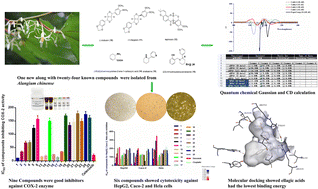Bioactive substances inhibiting COX-2 and cancer cells isolated from the fibrous roots of Alangium chinense (Lour.) Harms
Abstract
Alangium chinense has been used as a traditional folk medicine for centuries to treat rheumatism, skin diseases, and diabetes by the people of Southeast Asia. However, the bioactive constituents inhibiting COX-2 and cancer cells (HepG2, Caco-2, HeLa) remain unclear. In this study one new (14) along with twenty-four known compounds (1–13, 15–25) were isolated from the fibrous roots of Alangium chinense by chromatographic methods, and identified by NMR, and Gaussian and CD calculation. Compounds 1, 2, 13, 16, 17, 19, 20, 23, and 24 were isolated from this plant for the first time. Their inhibition effects on COX-2 enzyme and cancer cells were evaluated by MTT assay. Compounds 1–4, 13–14, and 16–18 can be used as good inhibitors against COX-2 enzyme, and compounds 1, 13, 14, and 17 were stronger than the positive control (celecoxib). In addition, molecular docking suggested that compounds 13, 17, and 18 belong to ellagic acids and have good inhibition against COX-2 enzyme. While compounds 1, 5, 13 and 21 showed cytotoxicity against HepG2 cells, compounds 2 and 21 showed cytotoxicity against Caco-2 cells, and compound 20 showed cytotoxicity against HeLa cells.



 Please wait while we load your content...
Please wait while we load your content...